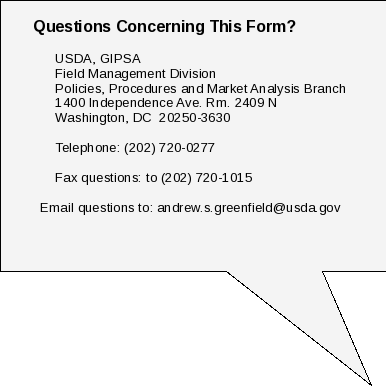FGIS 952 Sanitation Inspection Report (Processed Products)
Reporting and Recordkeeping Requirements (US Grain Standards Act and Agricultural Marketing Act of 1946)
fgis-952.xls
Reporting and Recordkeeping Requirements - Private Sector
OMB: 0580-0013
⚠️ Notice: This form may be outdated. More recent filings and information on OMB 0580-0013 can be found here:
Document [xlsx]
Download: xlsx | pdf
REVERSE
EXHIBIT FRONT
EXHIBIT REVERSE
INSTRUCTIONS
CONTACT













Overview
FRONT PAGEREVERSE
EXHIBIT FRONT
EXHIBIT REVERSE
INSTRUCTIONS
CONTACT
Sheet 1: FRONT PAGE
| PAGE 1 OF 2 | |||||||||||||||||
| FORM APPROVED OMB NO. 0580-0013: According to the Paperwork Reduction Act of 1995, an agency may not conduct or sponsor, and a person is not required to respond to a collection of information unless it displays a valid OMB control number. The valid OMB control number for this information collection is 0580-0013. The time required is estimated to average 1.5 hours per response and 1 minute of recordkeeping, including the time for reviewing instructions, searching existing data sources, gathering and maintaining the data needed, and completing and reviewing the collection of information. | |||||||||||||||||
| SANITATION INSPECTION REPORT | |||||||||||||||||
| (PROCESSED PRODUCTS) | |||||||||||||||||
| SANITATION INSPECTION OF (Name and Address of Plant) | INSPECTOR | ||||||||||||||||
| DATE INSPECTED | |||||||||||||||||
| PLANT OWNED BY (Company or Individual) | INSPECTOR ACCOMPANIED BY (Name and Title) | ||||||||||||||||
| Assigned | Inspr's | Assigned | Inspr's | ||||||||||||||
| SANITARY DEFECTS | Defect | Defect | SANITARY DEFECTS | Defect | Defect | ||||||||||||
| Points | Points | Points | Points | ||||||||||||||
| I. | PREMISES | ||||||||||||||||
| A. | Outside premises not well drained. | 3 | |||||||||||||||
| B. | Outside premises not free of weeds, clutter, | VII. | DISPOSAL OF WASTES | ||||||||||||||
| unused equipment or other materials. | 3 | A. | Garbage, trash, and dry waste materials, inside or | ||||||||||||||
| C. | Waste not properly stored or contained. | 3 | outside the building, not satisfactorily contained. | 4 | |||||||||||||
| D. | Outside premises not free of harborage or breeding | B. | Waste is not disposed of frequently enough | ||||||||||||||
| places for insects, rodents, birds, or other animals. | 4 | to prevent unsightliness or undesirable odors. | 4 | ||||||||||||||
| E. | Approaches to docks not clean or treated to minimize | ||||||||||||||||
| dust. | 3 | VIII. | TOILET, HAND-WASHING, AND DRESSING ROOM | ||||||||||||||
| FACILITIES | |||||||||||||||||
| II. | RAW MATERIALS | A. | Toilet facilities not provided for each sex. | 3 | |||||||||||||
| A. | Raw materials used in the product not handled in a | ||||||||||||||||
| sanitary manner that would prevent adulteration of finished | B. | Toilets and urinals not water-flushed. | 3 | ||||||||||||||
| product. | Critical | C. | Toilet room(s) not equipped with self-closing | ||||||||||||||
| doors. | 3 | 3 | |||||||||||||||
| III. | CONSTRUCTION OF BUILDING | D. | Toilet room(s) open directly into a processing | ||||||||||||||
| A. | Plant construction does not exclude probable | or food storage room where food is exposed. | Critical | ||||||||||||||
| entrance of insects, rodents, birds or other animals. | 5 | E. | Cold and hot, water or tapped water not | ||||||||||||||
| B. | Walls, partitions, ceilings, and exposed structural | provided at wash basins. | 3 | ||||||||||||||
| supports in poor repair. | 3 | F. | Hand cleaner and towels not provided at or | ||||||||||||||
| C. | Floors not smooth and readily cleanable. | 3 | near each basin. | 3 | |||||||||||||
| D. | Floors that frequently get wet not constructed to | ||||||||||||||||
| prevent pooling or are not kept dry. | 3 | G. | Adequate hand-washing signs not posted. | 3 | |||||||||||||
| E. | Exposed, unprotected overhead sewer lines present | ||||||||||||||||
| in product lines. | Critical | H. | Adequate dry waste receptacles not provided. | 5 | |||||||||||||
| F. | Wooden floors, where present, not coated with a suitable | ||||||||||||||||
| floor seal that effectively minimizes cracks and crevices. | 5 | I. | Toilet facilities not working. | 4 | |||||||||||||
| G. | Walls not sealed at juncture with floor. | 3 | J. | Toilet and locker room not satisfactorily | |||||||||||||
| H. | Walls and ceilings not free of flaked paint, nor in good | ventilated. | 5 | ||||||||||||||
| repair. | 3 | K. | Toilet and dressing rooms not kept in a clean | ||||||||||||||
| orderly condition. | 5 | ||||||||||||||||
| I. | Windows not intact. | 3 | |||||||||||||||
| J. | Entrances to production rooms not equipped with | ||||||||||||||||
| self-closing doors nor provided with other effective means | IX. | CONSTRUCTION AND REPAIR OF EQUIPMENT | |||||||||||||||
| to prevent entrance of vermin. | 3 | A. | Equipment product contact surfaces not | ||||||||||||||
| constructed of smooth, nontoxic, corrosion- | |||||||||||||||||
| K. | Screen doors, where present, not self closing. | 3 | resistant, odorless, materials; wood, where used, | 4 | |||||||||||||
| L. | Utility rooms or areas, including boiler rooms and | not fine, close grained, high-density type. | 5 | ||||||||||||||
| maintenance shop, not isolated enough or separated from | B. | Equipment product zone surfaces not free of | |||||||||||||||
| production rooms. | 4 | cracks, crevices, pits, or other imperfections | |||||||||||||||
| (such as knots in wood). | 5 | ||||||||||||||||
| IV. | LIGHTING | C. | Adequate space not allowed around equipment | ||||||||||||||
| A. | Production rooms not adequately lighted (20-foot candles). | 3 | for cleaning and inspection purposes. | 4 | |||||||||||||
| B. | Places where detailed inspection of the product | D. | Equipment not designed to protect the product | ||||||||||||||
| or ingredients is required not adequately lighted | zone against contamination or extraneous | ||||||||||||||||
| (50-foot candles). | 4 | material. | 5 | ||||||||||||||
| C. | Places where detailed inspection of the processes or | E. | Equipment not free of parts or areas inaccessible | ||||||||||||||
| operations is required not adequately lighted | for cleaning and inspection purposes. | 4 | |||||||||||||||
| (50-foot candles). | 3 | F. | Electrical system not constructed or positioned | ||||||||||||||
| to prevent insect harborage. | 3 | ||||||||||||||||
| D. | Storage areas not adequately lighted (20-foot candles) | 3 | G. | Equipment not kept in good repair. | 2 for each item not in good repair | ||||||||||||
| E. | Toilets and dressing rooms not adequately lighted | ||||||||||||||||
| (20-foot candles). | 3 | ||||||||||||||||
| F. | Light bulbs, fixtures, skylights, or other glass suspended | X. | CLEANING | ||||||||||||||
| over food in any stage of preparation not of a safety type | A. | Equipment not cleaned at frequencies necessary | |||||||||||||||
| or otherwise protected where essential to prevent | to prevent contamination of the product. | Critical | |||||||||||||||
| contamination of the product during production. | 5 | B. | A dust-free method of cleaning not used | ||||||||||||||
| whenever possible. | 3 | ||||||||||||||||
| V. | VENTILATION | ||||||||||||||||
| A. | Plant not reasonably free of undesirable odors, hot air | XI. | CONTROL OF INSECTS AND ANIMALS | ||||||||||||||
| vapors, or dust. | 3 | A. | Presence of evidence of any rodents in plant. | 5 | |||||||||||||
| B. | Evidence or presence of excessive condensate on walls, | B. | Presence of any birds or any other animals | ||||||||||||||
| ceilings, equipment, or pipelines. | 4 | including domestic types in the plant. | 5 | ||||||||||||||
| C. | Areas where steam or hot air vapors are predominant not | C. | Presence of live insects in processing or product | ||||||||||||||
| effectively exhaust-ventilated. | 3 | storage areas(two or more). | Critical | ||||||||||||||
| D. | Cooling and air-conditioning units not equipped with | D. | Presence of dead insects in processing equipment | ||||||||||||||
| filtering devices; filters not changed or cleaned when | (two or more). | Critical | |||||||||||||||
| necessary. | 3 | E. | Presence of live or dead insects in other plant areas | ||||||||||||||
| E. | Window openings to the outside not screened with 14-mesh | (three or more). | 5 | ||||||||||||||
| or finer window screen (during presence of flies or other | F. | Rodenticides, insecticides, and other control | |||||||||||||||
| flying insects. | 3 | or eradication material including applicatory | |||||||||||||||
| F. | Exhaust fans not screened or equipped with self-closing | equipment not used in a safe acceptable manner. | Critical | ||||||||||||||
| louvers. | 3 | G. | Evidence that effective pest control not exercised | ||||||||||||||
| where needed. | 3 | ||||||||||||||||
| VI. | WATER SUPPLY | H. | Type of insecticides and rodenticides not in | ||||||||||||||
| A. | Lack of satisfactory evidence that the water supply is potable. | Critical | compliance with Federal Food and Drug | ||||||||||||||
| B. | Presence of a cross-connection between water lines and | Administration regulations. | 4 | ||||||||||||||
| sewage system (not allowed). | Critical | I. | Poisoned baits, if used, not adequately secured. | ||||||||||||||
| 5 | |||||||||||||||||
| FORM FGIS 952 (7-02) (Replaces Form FGIS-952 (1-84). Expires January 2015 | |||||||||||||||||
Sheet 2: REVERSE
| PAGE 2 OF 2 | |||||||||||||||||
| Assigned | Inspr's | Assigned | Inspr's | ||||||||||||||
| SANITARY DEFECTS | Defect | Defect | SANITARY DEFECTS | Defect | Defect | ||||||||||||
| Points | Points | Points | Points | ||||||||||||||
| XII. | COOLING AND REFRIGERATION FACILITIES | XIV. | PERSONNEL | ||||||||||||||
| A. | Perishable supplies and products not adequately | A. | Employees not wearing garments suitable for | ||||||||||||||
| protected from contamination or from | work being performed. | 4 | |||||||||||||||
| becoming spoiled. | 5 | B. | Personnel in contact with unwrapped product or | ||||||||||||||
| B. | Storage areas not free of visible mold and | ingredients not using proper headwear | |||||||||||||||
| objectionable odors. | 3 | including protection from facial hair. | 4 | ||||||||||||||
| C. | Storage area not reasonably clean. | 3 | C. | Fingernail polish, costume jewelry, and | |||||||||||||
| D. | Where required refrigeration facilities not | 3 | wrist watches worn by plant personnel | ||||||||||||||
| properly cooling and keeping perishable | working on the processing line. | 3 | |||||||||||||||
| supplies and products at temperatures | D. | Gloves, if worn, not kept in a sanitary condition. | 3 | ||||||||||||||
| not exceeding 45 degrees F. | 5 | E. | Storage of employees personal effects in | ||||||||||||||
| E. | Adequate skids or pallets not used when | production rooms. | 3 | ||||||||||||||
| needed. | 3 | F. | Employees not washing hands after | ||||||||||||||
| F. | Items not stored in an orderly, easily | contamination. | Critical | ||||||||||||||
| accessible manner in suitable, covered, or | G. | Failure of employees to be hygienically | 3 | ||||||||||||||
| closed containers. | 3 | clean: fingernails not kept clean and | |||||||||||||||
| trimmed. | 4 | ||||||||||||||||
| XIII. | STORING AND STORAGE FACILITIES | H. | Employees affected with or a carrier | ||||||||||||||
| A. | Supplies and products not adequately | of a communicable or infectious disease | |||||||||||||||
| protected from contamination nor | not excluded from product area. | Critical | |||||||||||||||
| from becoming spoiled. | 5 | I. | Plant employees having an infectious wound, sore, | ||||||||||||||
| B. | Storage areas not well ventilated and | or lesion on hands, arms, or other exposed parts of | |||||||||||||||
| free from objectionable odors. | 3 | the body not excluded from contacting | |||||||||||||||
| ingredients, products, or product zone. | 5 | ||||||||||||||||
| C. | Storage areas not clean and dry. | 3 | J. | Plant personnel not instructed in | |||||||||||||
| D. | Materials not stored in an orderly manner | acceptable hygienic practices and proper | |||||||||||||||
| in suitable, covered, or closed containers. | 3 | sanitary rules of food handling. | 5 | ||||||||||||||
| E. | Supplies and product not protected | K. | Personnel not prohibited from | ||||||||||||||
| against unfavorable temperatures and | expectorating, eating, or smoking | ||||||||||||||||
| humidity. | 3 | in product areas. | 5 | ||||||||||||||
| F. | Adequate skids or pallets not used where | ||||||||||||||||
| needed. | 3 | TOTAL…………………………………………………………………… | |||||||||||||||
| Plant operations are considered to be insanitary if one or more critical defects are found or if the plant receives a score of 76 or higher. | |||||||||||||||||
| When Section XII, "Cooling and Refrigeration Facilities" is not applicable, the plant must have a score of 54 or higher. | |||||||||||||||||
| REMARKS | |||||||||||||||||
| FORM FGIS 952 (7-02) Reverse | |||||||||||||||||
Sheet 3: EXHIBIT FRONT
| PAGE 1 OF 2 | |||||||||||||||||
| FORM APPROVED OMB NO. 0580-0013: According to the Paperwork Reduction Act of 1995, no persons are required to respond to a collection of information unless it displays a valid OMB control number for this information collection is 00580-0013. The time required is estimated to average 1.5 hours per response and 1 minute of recordkeeping, including the time for reviewing instructions, searching existing data sources, gathering and maintaining the data needed, and completing and reviewing the collection of information. | |||||||||||||||||
| SANITATION INSPECTION REPORT | |||||||||||||||||
| (PROCESSED PRODUCTS) | |||||||||||||||||
| SANITATION INSPECTION OF (Name and Address of Plant) | INSPECTOR | ||||||||||||||||
| DATE INSPECTED | |||||||||||||||||
| PLANT OWNED BY (Company or Individual) | INSPECTOR ACCOMPANIED BY (Name and Title) | ||||||||||||||||
| Assigned | Inspr's | Assigned | Inspr's | ||||||||||||||
| SANITARY DEFECTS | Defect | Defect | SANITARY DEFECTS | Defect | Defect | ||||||||||||
| Points | Points | Points | Points | ||||||||||||||
| I. | PREMISES | ||||||||||||||||
| A. | Outside premises not well drained. | 3 | |||||||||||||||
| B. | Outside premises not free of weeds, clutter, | VII. | DISPOSAL OF WASTES | ||||||||||||||
| unused equipment or other materials. | 3 | A. | Garbage, trash, and dry waste materials, inside or | ||||||||||||||
| C. | Waste not properly stored or contained. | 3 | outside the building, not satisfactorily contained. | 4 | |||||||||||||
| D. | Outside premises not free of harborage or breeding | B. | Waste is not disposed of frequently enough | ||||||||||||||
| places for insects, rodents, birds, or other animals. | 4 | to prevent unsightliness or undesirable odors. | 4 | ||||||||||||||
| E. | Approaches to docks not clean or treated to minimize | ||||||||||||||||
| dust. | 3 | VIII. | TOILET, HAND-WASHING, AND DRESSING ROOM | ||||||||||||||
| FACILITIES | |||||||||||||||||
| II. | RAW MATERIALS | A. | Toilet facilities not provided for each sex. | 3 | |||||||||||||
| A. | Raw materials used in the product not handled in a | ||||||||||||||||
| sanitary manner that would prevent adulteration of finished | B. | Toilets and urinals not water-flushed. | 3 | ||||||||||||||
| product. | Critical | C. | Toilet room(s) not equipped with self-closing | ||||||||||||||
| doors. | 3 | 3 | |||||||||||||||
| III. | CONSTRUCTION OF BUILDING | D. | Toilet room(s) open directly into a processing | ||||||||||||||
| A. | Plant construction does not exclude probable | or food storage room where food is exposed. | Critical | ||||||||||||||
| entrance of insects, rodents, birds or other animals. | 5 | E. | Cold and hot, water or tapped water not | ||||||||||||||
| B. | Walls, partitions, ceilings, and exposed structural | provided at wash basins. | 3 | ||||||||||||||
| supports in poor repair. | 3 | F. | Hand cleaner and towels not provided at or | ||||||||||||||
| C. | Floors not smooth and readily cleanable. | 3 | near each basin. | 3 | |||||||||||||
| D. | Floors that frequently get wet not constructed to | ||||||||||||||||
| prevent pooling or are not kept dry. | 3 | G. | Adequate hand-washing signs not posted. | 3 | |||||||||||||
| E. | Exposed, unprotected overhead sewer lines present | ||||||||||||||||
| in product lines. | Critical | H. | Adequate dry waste receptacles not provided. | 5 | |||||||||||||
| F. | Wooden floors, where present, not coated with a suitable | ||||||||||||||||
| floor seal that effectively minimizes cracks and crevices. | 5 | I. | Toilet facilities not working. | 4 | |||||||||||||
| G. | Walls not sealed at juncture with floor. | 3 | J. | Toilet and locker room not satisfactorily | |||||||||||||
| H. | Walls and ceilings not free of flaked paint, nor in good repair. | ventilated. | 5 | ||||||||||||||
| repair. | 3 | K. | Toilet and dressing rooms not kept in a clean | ||||||||||||||
| orderly condition. | 5 | ||||||||||||||||
| I. | Windows not intact. | 3 | |||||||||||||||
| J. | Entrances to production rooms not equipped with | ||||||||||||||||
| self-closing doors nor provided with other effective means | IX. | CONSTRUCTION AND REPAIR OF EQUIPMENT | |||||||||||||||
| to prevent entrance of vermin. | 3 | A. | Equipment product contact surfaces not | ||||||||||||||
| constructed of smooth, nontoxic, corrosion- | |||||||||||||||||
| K. | Screen doors, where present, not self closing. | 3 | resistant, odorless, materials; wood, where used, | 4 | |||||||||||||
| L. | Utility rooms or areas, including boiler rooms and | not fine, close grained, high-density type. | 5 | ||||||||||||||
| maintenance shop, not isolated enough or separated from | B. | Equipment product zone surfaces not free of | |||||||||||||||
| production rooms. | 4 | cracks, crevices, pits, or other imperfections | |||||||||||||||
| (such as knots in wood). | 5 | ||||||||||||||||
| IV. | LIGHTING | C. | Adequate space not allowed around equipment | ||||||||||||||
| A. | Production rooms not adequately lighted (20-foot candles). | 3 | for cleaning and inspection purposes. | 4 | |||||||||||||
| B. | Places where detailed inspection of the product | D. | Equipment not designed to protect the product | ||||||||||||||
| or ingredients is required not adequately lighted | zone against contamination or extraneous | ||||||||||||||||
| (50-foot candles). | 4 | material. | 5 | ||||||||||||||
| C. | Places where detailed inspection of the processes or | E. | Equipment not free of parts or areas inaccessible | ||||||||||||||
| operations is required not adequately lighted | for cleaning and inspection purposes. | 4 | |||||||||||||||
| (50-foot candles). | 3 | F. | Electrical system not constructed or positioned | ||||||||||||||
| to prevent insect harborage. | 3 | ||||||||||||||||
| D. | Storage areas not adequately lighted (20-foot candles) | 3 | G. | Equipment not kept in good repair. | 2 for each item not in good repair | ||||||||||||
| E. | Toilets and dressing rooms not adequately lighted | ||||||||||||||||
| (20-foot candles). | 3 | ||||||||||||||||
| F. | Light bulbs, fixtures, skylights, or other glass suspended | X. | CLEANING | ||||||||||||||
| over food in any stage of preparation not of a safety type | A. | Equipment not cleaned at frequencies necessary | |||||||||||||||
| or otherwise protected where essential to prevent | to prevent contamination of the product. | Critical | |||||||||||||||
| contamination of the product during production. | 5 | B. | A dust-free method of cleaning not used | ||||||||||||||
| whenever possible. | 3 | ||||||||||||||||
| V. | VENTILATION | ||||||||||||||||
| A. | Plant not reasonably free of undesirable odors, hot air | XI. | CONTROL OF INSECTS AND ANIMALS | ||||||||||||||
| vapors, or dust. | 3 | A. | Presence of evidence of any rodents in plant. | 5 | |||||||||||||
| B. | Evidence or presence of excessive condensate on walls, | B. | Presence of any birds or any other animals | ||||||||||||||
| ceilings, equipment, or pipelines. | 4 | including domestic types in the plant. | 5 | ||||||||||||||
| C. | Areas where steam or hot air vapors are predominant not | C. | Presence of live insects in processing or product | ||||||||||||||
| effectively exhaust-ventilated. | 3 | storage areas(two or more). | Critical | ||||||||||||||
| D. | Cooling and air-conditioning units not equipped with | D. | Presence of dead insects in processing equipment | ||||||||||||||
| filtering devices; filters not changed or cleaned when | (two or more). | Critical | |||||||||||||||
| necessary. | 3 | E. | Presence of live or dead insects in other plant areas | ||||||||||||||
| E. | Window openings to the outside not screened with 14-mesh | (three or more). | 5 | ||||||||||||||
| or finer window screen (during presence of flies or other | F. | Rodenticides, insecticides, and other control | |||||||||||||||
| flying insects. | 3 | or eradication material including applicatory | |||||||||||||||
| F. | Exhaust fans not screened or equipped with self-closing | equipment not used in a safe acceptable manner. | Critical | ||||||||||||||
| louvers. | 3 | G. | Evidence that effective pest control not exercised | ||||||||||||||
| where needed. | 3 | ||||||||||||||||
| VI. | WATER SUPPLY | H. | Type of insecticides and rodenticides not in | ||||||||||||||
| A. | Lack of satisfactory evidence that the water supply is potable. | Critical | compliance with Federal Food and Drug | ||||||||||||||
| B. | Presence of a cross-connection between water lines and | Administration regulations. | 4 | ||||||||||||||
| sewage system (not allowed). | Critical | I. | Poisoned baits, if used, not adequately secured. | ||||||||||||||
| 5 | |||||||||||||||||
| FORM FGIS 952 (7-02) (Replaces Form FGIS-952 (1-84) | |||||||||||||||||


Sheet 4: EXHIBIT REVERSE
| PAGE 2 OF 2 | ||||||||||||||||||
| Assigned | Inspr's | Assigned | Inspr's | |||||||||||||||
| SANITARY DEFECTS | Defect | Defect | SANITARY DEFECTS | Defect | Defect | |||||||||||||
| Points | Points | Points | Points | |||||||||||||||
| XII. | COOLING AND REFRIGERATION FACILITIES | XIV. | PERSONNEL | |||||||||||||||
| A. | Perishable supplies and products not adequately | A. | Employees not wearing garments suitable for | |||||||||||||||
| protected from contamination or from | work being performed. | 4 | ||||||||||||||||
| becoming spoiled. | 5 | B. | Personnel in contact with unwrapped product or | |||||||||||||||
| B. | Storage areas not free of visible mold and | ingredients not using proper headwear | ||||||||||||||||
| objectionable odors. | 3 | including protection from facial hair. | 4 | |||||||||||||||
| C. | Storage area not reasonably clean. | 3 | C. | Fingernail polish, costume jewelry, and | ||||||||||||||
| D. | Where required refrigeration facilities not | 3 | wrist watches worn by plant personnel | |||||||||||||||
| properly cooling and keeping perishable | working on the processing line. | 3 | ||||||||||||||||
| supplies and products at temperatures | D. | Gloves, if worn, not kept in a sanitary condition. | 3 | |||||||||||||||
| not exceeding 45 degrees F. | 5 | E. | Storage of employees personal effects in | |||||||||||||||
| E. | Adequate skids or pallets not used when | production rooms. | 3 | |||||||||||||||
| needed. | 3 | F. | Employees not washing hands after | |||||||||||||||
| F. | Items not stored in an orderly, easily | contamination. | Critical | |||||||||||||||
| accessible manner in suitable, covered, or | G. | Failure of employees to be hygienically | 3 | |||||||||||||||
| closed containers. | 3 | clean: fingernails not kept clean and | ||||||||||||||||
| trimmed. | 4 | |||||||||||||||||
| XIII. | STORING AND STORAGE FACILITIES | H. | Employees affected with or a carrier | |||||||||||||||
| A. | Supplies and products not adequately | of a communicable or infectious disease | ||||||||||||||||
| protected from contamination nor | not excluded from product area. | Critical | ||||||||||||||||
| from becoming spoiled. | 5 | I. | Plant employees having an infectious wound, sore, | |||||||||||||||
| B. | Storage areas not well ventilated and | or lesion on hands, arms, or other exposed parts of | ||||||||||||||||
| free from objectionable odors. | 3 | the body not excluded from contacting | ||||||||||||||||
| ingredients, products, or product zone. | 5 | |||||||||||||||||
| C. | Storage areas not clean and dry. | 3 | J. | Plant personnel not instructed in | ||||||||||||||
| D. | Materials not stored in an orderly manner | acceptable hygienic practices and proper | ||||||||||||||||
| in suitable, covered, or closed containers. | 3 | sanitary rules of food handling. | 5 | |||||||||||||||
| E. | Supplies and product not protected | K. | Personnel not prohibited from | |||||||||||||||
| against unfavorable temperatures and | expectorating, eating, or smoking | |||||||||||||||||
| humidity. | 3 | in product areas. | 5 | |||||||||||||||
| F. | Adequate skids or pallets not used where | |||||||||||||||||
| needed. | 3 | TOTAL…………………………………………………………………… | ||||||||||||||||
| Plant operations are considered to be unsanitary if one or more critical defects are found or if the plant receives a score of 76 or higher. | ||||||||||||||||||
| When Section XII, "Cooling and Refrigeration Facilities" is not applicable, the plant must have a score of 54 or higher. | ||||||||||||||||||
| REMARKS | ||||||||||||||||||
| FORM FGIS 952 (7-02) Reverse | ||||||||||||||||||


Sheet 5: INSTRUCTIONS
| SANITATION INSPECTION REPORT (SIR) | ||||||||
| FGIS‑952, For Processed Product and Rice Processing Plants. | ||||||||
| 1. Name of plant and physical address of the sanitation inspection. | ||||||||
| 2. Name of the company or individual that owns the plant. | ||||||||
| 3. Name of the inspector performing the inspection. | ||||||||
| 4. Date of inspection. | ||||||||
| 5. Name and title of plant personnel that accompanied the inspector during the inspection. | ||||||||
| 6. Assigned Defect Points. This column contains pre-assigned individual defect points. The range of points assigned is based on the importance of the defect item to the maintenance of good sanitation in the plant. For example, the defect item "Presence or evidence of rodents in plant," is assigned a point range of 0 to 5; whereas, "Waste not properly stored or contained," is assigned a point range of 0 to 3. | ||||||||
| 7. Inspector’s Defect Points. In this column rate the individual defect item based on your opinion as to the relative potential for product contamination. If the item is clean and presents no sanitation problem, assign 0 defect points to the item. If the item is relatively clean but not perfect, assign 1 or 2 defect points to the item. If the item is insanitary or presents a clear hazard to sanitary operations, assign the maximum defect points possible for that item. | ||||||||
| 8. Total the inspector’s defect points. If the SIR score meets or exceeds 76, consider plant operations insanitary. When section XII, Cooling and Refrigeration Facilities, is not applicable, delete the assigned defect points (22) from the total overall score of 76 or higher and use 54 or higher as the defect limit. | ||||||||
| 9. Explain critical defects in the "Remarks" section to clearly describe the conditions observed. | ||||||||
| Immediately after completing the SIR, give a copy to the plant representative. This copy is the plant's written notification of the conditions found. | ||||||||
Sheet 6: CONTACT

|
|||||||

|
|||||||
| File Type | application/vnd.ms-excel |
| File Title | SANITATION INSPECTION REPORT (PROCESSED PRODUCTS) |
| Author | USDA GIPSA FGIS |
| Last Modified By | ASGreenfield |
| File Modified | 2011-03-16 |
| File Created | 2002-06-06 |
© 2025 OMB.report | Privacy Policy